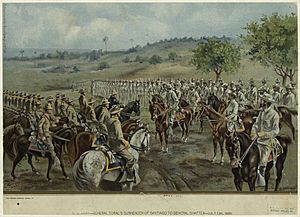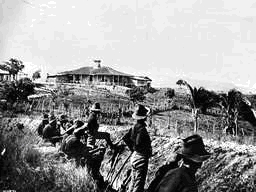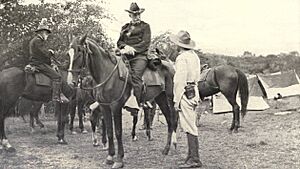Siege of Santiago facts for kids
Quick facts for kids Siege of Santiago |
|||||||
|---|---|---|---|---|---|---|---|
| Part of the Spanish–American War | |||||||
 General Toral's surrender of Santiago to General Shafter, July 13th, 1898, Unknown author |
|||||||
|
|||||||
| Belligerents | |||||||
| Commanders and leaders | |||||||
| Strength | |||||||
| 19,000 | 13,500 | ||||||
| Casualties and losses | |||||||
| 1,614 killed and wounded | 2,000 killed and wounded 11,500 captured |
||||||
The Siege of Santiago was the final major battle on the island of Cuba during the Spanish–American War. It involved American and Cuban forces surrounding the city of Santiago to force the Spanish army to surrender. This event was a key part of the war, leading to a victory for the United States and Cuba.
The Fight for Santiago
The main goal for the American army in Cuba was to capture the city of Santiago de Cuba. American troops first pushed back Spanish defenses at the Battle of Las Guasimas. After this, the Spanish general, Arsenio Linares, moved his soldiers back to a stronger defense line around Santiago. This line was along the San Juan Heights.
During the Battle of San Juan Hill, American forces bravely charged and captured the Spanish positions. On the same day, at the Battle of El Caney, U.S. troops also took a strong Spanish fort. This allowed them to extend their control around San Juan Hill. The Spanish navy was defeated in the Battle of Santiago de Cuba. This meant American forces could safely surround the city without worrying about attacks from the sea.
Surrounding the City
On July 3, 1898, the same day the Spanish navy was destroyed, Major General William Rufus Shafter began to surround Santiago. General Shafter made his army's position stronger on San Juan Heights. General Henry Ware Lawton's troops moved from El Caney to extend the American line to the north. To the northwest, Cuban rebels led by Calixto Garcia helped stretch the American line all the way to the bay.
General Arsenio Linares was badly hurt at the Battle of San Juan Hill. General José Toral y Velázquez took his place. The Spanish also had German military experts helping them with their cannons. General Toral had a very strong defensive position. Shafter knew that attacking head-on would cause many American soldiers to be hurt or killed.
The Americans began their siege, which means they surrounded the city and cut off supplies. American cannons on the heights fired into the city. U.S. forces, with help from Cuban rebels, stopped all water and food from reaching Santiago. On July 3, a small group of Spanish soldiers managed to get through the Cuban rebels to reach the city. This brought General Toral's total force to 13,500 soldiers.
On July 4, a break in fighting was agreed upon. This allowed about 20,000 people who were not soldiers to leave the city safely. Also on July 4, four Gatling guns were moved to Fort Canosa to help with the siege. A dynamite gun and sixteen other cannons were also brought in. Over the next thirteen days, the Gatling guns fired many rounds into Santiago.
On July 8, General Toral suggested surrendering Santiago if his troops could go to Holguin. Officials in Washington did not agree to this. So, the break in fighting ended on July 10. General Shafter was now in a hurry because Yellow fever was starting to spread among his troops. Shafter and the U.S. Navy, led by William T. Sampson, continued to bomb the city. General Miles arrived on July 11 with more soldiers and cannons.
The Surrender
Everyone involved wanted the fighting to end quickly. On July 13, at 9:00 AM, General Toral, General Shafter, General Miles, and General Joseph Wheeler met. They sat under a large tree between their army lines to talk about how the Spanish would surrender. The Americans offered to send the Spanish soldiers back to Spain.
Shafter asked his friend, Dr. George E. Goodfellow, to help with the surrender talks. Dr. Goodfellow spoke Spanish very well. He helped make the meeting friendly and successful.
On July 16, both governments agreed to the terms. General Toral surrendered his soldiers and all other troops in the Santiago area, which was about 9,000 more soldiers. The Spanish also gave up Guantanamo City and San Luis. The Spanish troops marched out of Santiago on July 17.
What Happened Next
The siege of Santiago mostly ended the major fighting in Cuba. However, the war was not completely over. Yellow fever had spread among the U.S. Army before the surrender. By July 28, about 4,000 U.S. soldiers were sick with malaria, yellow fever, and dysentery. Many officers, including Theodore Roosevelt, wanted the army to leave Cuba. They wrote a letter, known as the Round Robin, which was shared with the news.
The American Fifth Army Corps was called back home. They went to Camp Wikoff. Out of 20,000 men sent there, only 257 died from yellow fever or malaria.
The Red Cross ship, City of Texas, with Clara Barton on board, was the first ship to enter Santiago harbor. Plans were made for a big attack on Havana. However, the next major part of the war happened in Puerto Rico, led by General Miles.
See also
 In Spanish: Asedio de Santiago de Cuba para niños
In Spanish: Asedio de Santiago de Cuba para niños



